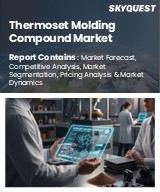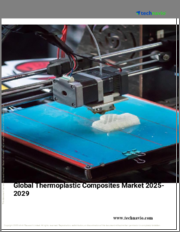
|
시장보고서
상품코드
1733805
열가소성 복합재료 시장 : 섬유 유형, 제품 유형, 수지 유형, 용도 산업, 지역별(2026-2032년)Thermoplastic Composites Market By Fiber Type, Product Type (Glass Mat Thermoplastics, Advanced Thermoplastic Composites ), Resin Type, Application Industry, & Region For 2026-2032 |
||||||
열가소성 복합재료 시장 평가 - 2026-2032년
열가소성 복합재료 시장의 급속한 확장은 자동차, 항공우주, 건설을 포함한 산업에서 경량 고강도 재료에 대한 수요 증가가 주요 원동력입니다. 게다가 지속 가능성과 재활용 가능성에 대한 강조가 커지면서 전통적인 열경화성 복합재보다 순환 경제 개념에 더 잘 맞는 열가소성 복합재료의 개발이 추진되고 있습니다.
열가소성 복합재료의 비용 대비 효과와 공정효율의 향상도 시장성장의 원동력이 되고 있습니다. 산업에서 열가소성 복합재료의 새로운 길을 열어 미래에 필수적인 재료로서의 입지를 확실히 하고 있습니다.
열가소성 복합재료 시장 정의/개요
열가소성 복합재료는 열가소성 매트릭스와 유리, 탄소, 아라미드 등의 강화 섬유로 구성된 고도의 재료입니다. 열경화성 복합재가 영구적으로 경화되는 것과 달리, 열가소성 매트릭스는 구조적 무결성을 잃지 않고 반복적으로 녹이고 변형될 수 있습니다. 이 특징은 강한 내충격성과 유연성이 요구되는 장면에서 특히 유용합니다.
열가소성 복합재료는 항공우주, 자동차, 스포츠 등 다양한 산업에서 채택되고 있습니다. 계속 가능한 제조와 재활용에 있어 그 사용이 늘어날 것으로 예측되고 있습니다.
항공우주산업 수요 증가는 열가소성 복합재료 시장을 어떻게 견인하는가?
열가소성 복합재료 시장은 항공우주산업에서 수요 증가를 뒷받침하고 있습니다. 이에 따라 세계 항공 여객 수송량은 2037년까지 두배로 증가하여 연간 82억명에 달할 것으로 예상되고 있으며, 연료 효율이 높은 항공기에 대한 요구가 높아지고 있습니다.
자동차 용도의 확대가 열가소성 복합재 시장을 뒷받침합니다. 자동차 업계에서는 자동차의 경량화와 연비 향상을 위해 열가소성 복합재료의 사용이 증가하고 있으며, 이것은 중요한 측면입니다. 자동차의 2019년 평균 CO2 배출량은 122.4g/km였습니다.
재료 비용 상승은 열가소성 복합재료 시장에 어떤 영향을 미치는가?
재료 비용의 상승은 열가소성 복합재료 시장에 영향을 미칩니다. 높은 가격은 특히 비용에 민감한 산업에서 열가소성 복합재료의 전반적인 가치감과 시장 침투에 영향을 미칠 수 있습니다.
공급망의 혼란은 열가소성 복합재료 시장에 영향을 미칩니다. 공급망의 혼란은 원재료 부족, 리드 타임의 장기화, 비용 상승을 초래할 수 있으며, 이들은 모두 열가소성 복합재료의 제조 및 입수를 방해합니다. 제품을 공급하는 능력을 제한할 수 있으며, 그 결과 다양한 산업에서 열가소성 복합재료의 채용을 제한하게 됩니다.
목차
제1장 서론
- 시장의 정의
- 시장 세분화
- 조사 방법
제2장 주요 요약
- 주요 조사 결과
- 시장 개요
- 시장 하이라이트
제3장 시장 개요
- 시장 규모와 성장 가능성
- 시장 동향
- 시장 성장 촉진요인
- 시장 성장 억제요인
- 시장 기회
- Porter's Five Forces 분석
제4장 열가소성 복합재료 시장 : 강화 섬유 유형별
- 유리섬유 강화 열가소성 복합재료
- 탄소섬유 강화 열가소성 복합재료
- 천연섬유 강화 열가소성 복합재료
- 아라미드 섬유 강화 열가소성 복합재료
제5장 열가소성 복합재료 시장 : 제조 공정별
- 압축 성형
- 사출 성형
- 상용 섬유 강화 프로세스
- 열가소성 프리프레그
제6장 열가소성 복합재료 시장 : 용도 산업별
- 자동차
- 항공우주
- 건설
- 소비재
- 에너지
제7장 지역 분석
- 북미
- 미국
- 캐나다
- 멕시코
- 유럽
- 영국
- 독일
- 프랑스
- 이탈리아
- 아시아태평양
- 중국
- 일본
- 인도
- 호주
- 라틴아메리카
- 브라질
- 아르헨티나
- 칠레
- 중동 및 아프리카
- 남아프리카
- 사우디아라비아
- 아랍에미리트(UAE)
제8장 시장 역학
- 시장 성장 촉진요인
- 시장 성장 억제요인
- 시장 기회
- 시장에 대한 COVID-19의 영향
제9장 경쟁 구도
- 주요 기업
- 시장 점유율 분석
제10장 기업 프로파일
- SABIC(Saudi Arabia)
- Celenase Corporation(US)
- BASF SE(Germany)
- Lanxess AG(Germany)
- Solvay SA(Belgium)
- Mitsubishi Chemical Advanced Materials(Japan)
- SGL Group(Germany)
- Dow(US)
- Toray Industries, Inc.(Japan)
제11장 시장 전망과 기회
- 신흥기술
- 향후 시장 동향
- 투자 기회
제12장 부록
- 약어 목록
- 출처와 참고문헌
Thermoplastic Composites Market Valuation - 2026-2032
The rapid expansion of the thermoplastic composites market. The growing demand for lightweight, high-strength materials in industries including automotive, aerospace, and construction is a major driver. These materials provide substantial benefits in terms of fuel efficiency, cargo capacity, and structural strength. Furthermore, the growing emphasis on sustainability and recyclability is driving the development of thermoplastic composites, which fit better with circular economy concepts than traditional thermoset composites. the market size surpass USD 38.66 Billion valued in 2024 to reach a valuation of around USD 69.99 Billion by 2032.
The increasing cost-effectiveness and process efficiency of thermoplastic composites are also driving market growth. Their ability to be processed using traditional thermoforming procedures lowers manufacturing costs and time, making them an appealing option for a variety of applications. Furthermore, continual advances in material science are widening the range of possibilities, opening up new paths for thermoplastic composites in a variety of industries, and confirming their position as a vital material for the future. The rising demand for cost-effective and efficient thermoplastic composites is enabling the market grow at a CAGR of 7.70% from 2026 to 2032.
Thermoplastic Composites Market: Definition/ Overview
Thermoplastic composites are sophisticated materials that consist of a thermoplastic matrix and reinforcing fibers such as glass, carbon, or aramid. Unlike thermosetting composites, which cure permanently, thermoplastic matrices can be melted and modified repeatedly without losing structural integrity. This feature makes them especially useful in situations requiring strong impact resistance and flexibility. These composites have a variety of qualities, including high strength-to-weight ratios, resistance to corrosion and fatigue, and excellent dimensional stability.
Thermoplastic composites are employed in various kinds of industries, including aerospace, automotive, and sports. Their capacity to be reshaped and recycled makes them excellent for applications requiring lightweight but durable parts, such as airplane components and high-performance cars. In the future, advances in processing methods and material formulations are projected to increase their use, particularly in sustainable manufacturing and recycling. As industries seek more environmentally friendly solutions, thermoplastic composites' potential for waste reduction and energy-efficient manufacturing processes will rise in importance, propelling their growth and innovation in the years.
How Does the Increasing Demand in the Aerospace Industry Drive the Thermoplastic Composites Market?
The thermoplastic composites market propels the increasing demand in the aerospace industry. The sector's need for lightweight materials with a high strength-to-weight ratio makes thermoplastic composites an excellent choice. According to the International Air Transport Association (IATA), worldwide air passenger traffic is expected to double by 2037 to 8.2 billion passengers per year, increasing the need for fuel-efficient aircraft. This expansion will drive the usage of thermoplastic composites, which help to cut fuel consumption and improve aircraft performance.
Growing automotive applications will propel the thermoplastic composites market. The automobile industry's increasing use of thermoplastic composites to reduce vehicle weight and enhance fuel efficiency is an important aspect. According to the European Automobile Manufacturers Association (ACEA), new passenger cars in the EU had an average CO2 emission of 122.4 g/km in 2019. Stricter emissions laws force manufacturers to adopt lightweight materials such as thermoplastic composites, increasing market demand to satisfy these demands and improve vehicle performance.
How Do the Higher Material Costs Impact the Thermoplastic Composites Market?
Higher material costs will influence the thermoplastic composites market. While thermoplastic composites provide considerable benefits such as reduced weight and greater fuel efficiency, their higher production costs when compared to traditional materials may be a barrier to wider use. These higher prices can have an impact on the overall affordability and market penetration of thermoplastic composites, especially in cost-sensitive industries. As a result, producers and researchers are constantly finding ways to lower manufacturing costs and enhance cost-efficiency, making these sophisticated materials more competitive and accessible.
Supply chain disruptions will affect the thermoplastic composites market. Disruptions in the supply chain can result in raw material shortages, longer lead times, and higher costs, all of which can hinder thermoplastic composite manufacturing and availability. These problems may limit producers' capacity to meet demand and deliver products on time, thereby limiting the adoption of thermoplastic composites in a variety of industries. To offset these effects, businesses may need to engage in supply chain resilience and diversification measures to ensure a consistent supply of critical components.
Category-Wise Acumens
Will the Demand for the Glass Fiber from Automotive Sector Fuel the Thermoplastic Composites Market?
The glass fiber segment currently dominates the thermoplastic composites market. The automotive industry will fuel the demand for glass fiber in the thermoplastic composites market. As the industry strives to lower vehicle weight and increase fuel efficiency to fulfill higher emissions standards, the use of lightweight materials such as glass fiber-reinforced thermoplastic composites is becoming more essential. Glass fiber provides an outstanding blend of strength, durability, and cost-effectiveness, making it a popular choice among car producers. The increased emphasis on lightweight and high-performance materials in the automobile industry is predicted to dramatically increase demand for glass fiber in thermoplastic composites.
The construction industry will fuel the demand for glass fiber in the thermoplastic composites market. Glass fiber-reinforced thermoplastic composites are gaining popularity as the construction industry looks for new ways to improve the durability, strength, and longevity of buildings and infrastructure. These materials are highly resistant to corrosion, dampness, and extreme climatic conditions, making them perfect for construction applications. The requirement for long-lasting, high-performance building materials will significantly boost demand for glass fiber in the thermoplastic composites market.
Will the Need for Thermoplastic Composites in the Aerospace & Defense Segment Boost the Market?
The aerospace and defense sector are currently the dominant segment of thermoplastic composites. The thermoplastic composites market will be driven by the aerospace and military segments. The aerospace and defense industries are increasingly using thermoplastic composites because of their lightweight qualities, high strength-to-weight ratio, and ease of manufacture and repair. These compounds help increase fuel efficiency and performance in aviation and defense equipment. As demand for innovative, fuel-efficient, and high-performance solutions rises in these industries, thermoplastic composites are likely to play an essential role, greatly increasing their market presence and driving growth in the aerospace and defense sectors.
The aerospace and defense segments of the thermoplastic composites market will be driven by the demand for lightweight materials. Lightweight materials are critical in both industries because they improve fuel efficiency, payload capacity, and overall performance of aircraft and defense equipment. Thermoplastic composites, recognized for their high strength-to-weight ratio, are increasingly being used to achieve these specifications. As the aerospace and military industries prioritize the development of more efficient and high-performance technologies, the adoption of lightweight thermoplastic composites will drive market expansion in these sectors.
Country/Region-wise Acumens
Will the Robust Manufacturing Infrastructure Bolster the Growth of the Market in North America?
North America has historically dominated the thermoplastic composites market. The robust manufacturing infrastructure in North America will drive the thermoplastic composites market. North America's well-developed supply network, advanced manufacturing facilities, and strong industrial base all contribute considerably to increased production and innovation in this area. With the U.S. manufacturing industry contributing USD 2.3 Trillion to GDP in 2021 and a projected 2.1 million new jobs by 2030, these factors, combined with a 13% increase in plastic resin production capacity between 2020 and 2025, support and boost demand for thermoplastic composites in the region.
North America's technological leadership is a key driver of the thermoplastic composites market, owing to its strong R&D capabilities and early adoption of new composite technologies. The region's drive to innovation promotes the development and use of cutting-edge thermoplastic composites in a variety of industries. In 2020, the United States invested USD 667 Billion in R&D, with plans to expand to USD 724 Billion by 2023, increasing progress in this area. According to the US Department of Energy, thermoplastic composites have the potential to cut vehicle weight by up to 50% while increasing fuel efficiency by up to 35%, accelerating their adoption in the automotive industry. North America continues to play an important role because of its technological leadership and innovation skills, which are growing applications in the aerospace, automotive, and renewable energy sectors.
Will the Rapid Industrialization in the Asia Pacific Region Drive the Thermoplastic Composites Market?
The Asia Pacific region is experiencing the most rapid growth in the thermoplastic composites market. Rapid industrialization will propel the Asia-Pacific region's thermoplastic composites market. The region's rapid economic expansion and urbanization, In the automotive, construction, and infrastructure sectors, are driving demand for new materials with higher performance. With the Asia-Pacific area forecast to grow by 4.8% in 2023 and 4.9% in 2024, as well as considerable infrastructure investments, demand for high-performance materials such as thermoplastic composites is expected to rise. Furthermore, the automotive sector's expansion, including China's output of 27.02 million units and India's "Make in India" effort aimed at increasing manufacturing's GDP contribution, reinforces this trend.
The expanding automobile market will fuel the Asia-Pacific thermoplastic composites market. The region's rapidly expanding automotive industry, with rising demand for lightweight, fuel-efficient, and electric vehicles, is opening up new potential for thermoplastic composites. Asia-Pacific accounted for 55% of global motor vehicle manufacturing in 2022, with China's new energy vehicle (NEV) sales predicted to increase by 35% year on year in 2023. Furthermore, India's automotive market is expected to reach USD 300 Billion by 2026, aided by a strong push for electric vehicles. This strong growth, fueled by the shift toward lightweight and environmentally friendly materials, will greatly increase demand for thermoplastic composites in the region.
Competitive Landscape
The thermoplastic composites market is a dynamic and competitive space, characterized by a diverse range of players vying for market share. These players are on the run for solidifying their presence through the adoption of strategic plans such as collaborations, mergers, acquisitions, and political support.
The organizations are focusing on innovating their product line to serve the vast population in diverse regions. Some of the prominent players operating in the market include:
- SABIC
- Celenase Corporation
- BASF SE
- Lanxess AG
- Solvay S.A.
- Mitsubishi Chemical Advanced Materials
- SGL Group
- Dow
- Toray Industries, Inc.
Latest Developments
- In April 2023, LANXESS announced the formation of a joint venture with Advent International focusing on engineering materials, which will start operations on April 1, 2023. DSM's Engineering Materials section and LANXESS's former High-Performance Materials business teamed up to form the new joint venture. LANXESS holds roughly 40% of the joint venture, while Advent International owns about 60%.
- In April 2023, Solvay and GKN Aerospace announced an extension of their partnership agreement, under which both companies will develop a combined thermoplastic composites (TPC) roadmap to investigate innovative materials and manufacturing techniques for aircraft structures, as well as jointly target future key high-rate programs. Furthermore, Solvay is projected to remain GKN Aerospace's primary supplier of TPC materials. Solvay's PEKK composites and films support GKN Aerospace's TPC development activities.
- In May 2022, DuPont plans to expand the production of Kapton(R) polyimide film and Pyralux(R) to fulfill the demands of the automotive and defense industries.
- In June 2022, DSM began a large-scale on-farm experiment to reduce greenhouse gas emissions.
- Analyst's Take
- The Thermoplastic Composites Market indicates a steady growth trajectory driven by increasing demand for lightweight and fuel-efficient materials in the automotive and aerospace sectors. The market is also influenced by advancements in manufacturing technologies, such as automated production processes and the development of novel thermoplastic resins. Moreover, the market's expansion is fueled by growing environmental concerns, leading to a shift towards recyclable and sustainable materials in various industries. Overall, the Thermoplastic Composites Market is expected to experience substantial growth opportunities in the coming years, propelled by ongoing innovations and applications across diverse end-use sectors.
TABLE OF CONTENTS
1. Introduction
- Market Definition
- Market Segmentation
- Research Methodology
2. Executive Summary
- Key Findings
- Market Overview
- Market Highlights
3. Market Overview
- Market Size and Growth Potential
- Market Trends
- Market Drivers
- Market Restraints
- Market Opportunities
- Porter's Five Forces Analysis
4. Thermoplastic Composites Market, By Type of Reinforcement Fiber
- Glass Fiber-Reinforced Thermoplastic Composites
- Carbon Fiber-Reinforced Thermoplastic Composites
- Natural Fiber-Reinforced Thermoplastic Composites
- Aramid Fiber-Reinforced Thermoplastic Composites
5. Thermoplastic Composites Market, By Manufacturing Process
- Compression Molding
- Injection Molding
- Continuous Fiber Reinforcement Processes
- Thermoplastic Prepregging
6. Thermoplastic Composites Market, By Application Industry
- Automotive
- Aerospace
- Construction
- Consumer Goods
- Energy
7. Regional Analysis
- North America
- United States
- Canada
- Mexico
- Europe
- United Kingdom
- Germany
- France
- Italy
- Asia-Pacific
- China
- Japan
- India
- Australia
- Latin America
- Brazil
- Argentina
- Chile
- Middle East and Africa
- South Africa
- Saudi Arabia
- UAE
8. Market Dynamics
- Market Drivers
- Market Restraints
- Market Opportunities
- Impact of COVID-19 on the Market
9. Competitive Landscape
- Key Players
- Market Share Analysis
10. Company Profiles
- SABIC (Saudi Arabia)
- Celenase Corporation (US)
- BASF SE (Germany)
- Lanxess AG (Germany)
- Solvay S.A. (Belgium)
- Mitsubishi Chemical Advanced Materials (Japan)
- SGL Group (Germany)
- Dow (US)
- Toray Industries, Inc. (Japan)
11. Market Outlook and Opportunities
- Emerging Technologies
- Future Market Trends
- Investment Opportunities
12. Appendix
- List of Abbreviations
- Sources and References



















